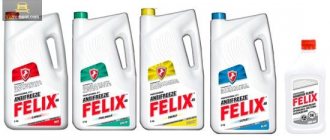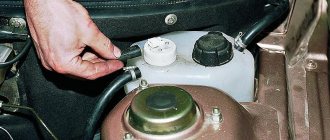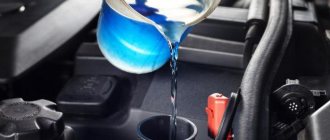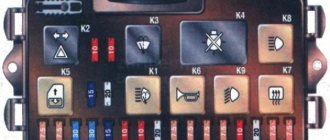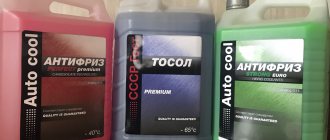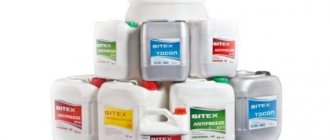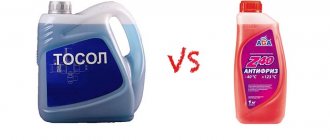01/24/2022 3,932 Cooling system
Author: Victor
The vehicle's engine cooling system must use a coolant that meets the powertrain standard. Regular operation of a car with expired antifreeze can contribute to overheating of the internal combustion engine. What is the boiling point of Antifreeze and what boiling of the engine can lead to, we will tell below.
[Hide]
Operating temperatures
Typically, the choice of a specific refrigerant depends not only on its color - an experienced car enthusiast will definitely pay attention to its temperature range in order to prevent the liquid from boiling. If necessary, you can even pour water into the system, but it already boils at 100 degrees Celsius. There are other options:
- blue and green antifreeze can withstand 109–115 degrees above zero;
- red works without problems when heated to 105–125 units;
- The G13 class “cooling” lasts up to 108–114 degrees.
You may be interested in: Use of antifreeze in northern regions
Refrigerant Application
The quality of the coolant greatly affects the thermal conductivity, operating and maximum operating temperature. To determine the boiling point of antifreeze, you need to pay attention to quality. For example, the boiling point of antifreeze “A 40” is 108-110 degrees.
Sometimes car enthusiasts come across a low-quality liquid that boils even earlier than water. The only way to reduce the likelihood of buying a counterfeit is to purchase a brand of antifreeze or antifreeze that has already been used.
For any antifreeze, the boiling point depends on pressure. As a rule, with increased pressure, the upper limit shifts upward. The coolant freezes at forty to sixty degrees below zero. Typically, antifreeze is changed after two to three years or every eighty thousand kilometers.
Water and antifreeze
In the first car models, ordinary water was used to cool engine systems. But at one hundred degrees the liquid boils, so under conditions of increased loads it is very ineffective. And besides, water freezes when the thermometer is zero. This fact has more than once caused various car breakdowns in the winter.
Chemists and engineers thought about the problem for a long time and found a solution. The new liquid - antifreeze - has a boiling point of 108-125 degrees Celsius. Of course, the spread in the value is quite large, but the figure depends on the type of additives in the composition, the pressure in the system and the overall quality of the liquid.
The cheapest antifreeze is produced in violation of traditional technology, which affects the composition and properties. Sometimes drivers complain about liquids that boil at eighty-five degrees. Undoubtedly, this is dangerous for the car. Sometimes it is better to pour distilled water into the tank rather than an incomprehensible mixture. You shouldn’t save too much on antifreeze, because car repairs can ultimately cost much more.
Pressure dependence
At atmospheric pressure, high-quality antifreeze boils, reaching 180-110 degrees. But increased pressure in the system also increases the maximum permissible value for boiling liquid.
If the system is working properly, the upper limit for antifreeze can be shifted to plus 130 degrees. Of course, the system must be completely sealed. The antifreeze tank must be tightly closed. This largely depends on the serviceability of the valve on the expander cap. A leaky cooling system causes the antifreeze to quickly overheat. Under pressure, antifreeze increases the engine's resistance to overheating.
Reasons for exceeding temperature parameters
It is worth understanding that refrigerant is not a panacea; it can boil. Normally, the antifreeze temperature is 90 degrees Celsius. Why does it start boiling? There may be several possible reasons:
- lack of coolant, which can be identified by looking under the hood. If the level of antifreeze in the expansion tank is much lower than normal, a leak or excessive evaporation of the refrigerant can be assumed;
- features of a specific closed-loop system. Excess heat is removed here using a special valve. Its breakdown can disrupt the process;
- the formation of air pockets after replacing antifreeze or in the presence of leaky connections;
- malfunctions of key components of the cooling system, for example, a thermostat or fan;
- contamination of the radiator, due to which it cannot work at full capacity.
Consequences of engine overheating
If antifreeze does not cope with its task of cooling the engine, you may encounter various troubles. Among the most likely, experts note the following:
- malfunction of valves or their breakdown;
- damage to the cylinder head gasket;
- deformation of piston partitions;
- problems with the cylinder head or other important engine elements.
A little physics
It is incorrect to talk about the boiling point of antifreeze in the specifics of antifreeze, since, firstly, antifreeze has a certain chemical composition, and its thermophysical characteristics are determined not only by temperature, but also by pressure. Secondly, antifreeze, which at one time was created exclusively for domestically produced engines, contains additives that ensure not only the operation of the car at low temperatures, but also its protection from a number of unfavorable factors:
- corrosion;
- wear;
- cavitation.
Antifreeze, unlike antifreeze, does not have a lubricating effect, and wear reduction is achieved due to a decrease in the temperature of the moving elements of the drive, with an increase in which the gaps are selected and the friction coefficient naturally increases.
If everything is more or less clear with the permissible temperature (no more than 90ºС), then with the pressure in the engine the situation is more complicated. To protect the engine from overheating, antifreeze is pumped at elevated pressures, which also affects the temperature of the liquid. For most brands, the actual pressure in the cylinder block is at least 1.2...1.3 at: it is then, according to the Clausius law, that the maximum temperature required for boiling liquids increases. Thus, the theoretically permissible boiling point of coolants can be 110...112ºС.
How to recognize boiling
Understanding that your coolant isn't doing its job as well as it should isn't all that difficult. True, this sight can impress or even frighten a beginner who has not encountered a similar situation. The “coolant” in the expansion tank literally begins to boil, so much so that these sounds can reach the driver and his passengers. Steam may even come out from under the hood, just like when ordinary water boils. You can also see an increase in the operating temperature of the motor. When the needle reaches the red zone, it is better to turn off the engine - further movement will not lead to anything good.
What happens when it boils
Interestingly, an increase in operating temperature can affect not only the operation of the engine, but also the quality of the coolant. It is logical that it has a certain service life. At high temperatures, the solution begins to degrade, and it is not the base itself that is destroyed, of which 95% of the “coolant” consists. Various additives lose their properties, including corrosion inhibitors, which help protect the metal elements of the system, including the thermostat and radiator, from rust. Brown coolant is a sure sign that the antifreeze has lost its properties and needs to be replaced.
G12 – red, yellow and orange
There are two types of red antifreeze - G12 and G12+, recently cheap G11, as well as green options have appeared, but we will talk about the original one. The first version 12 is cheaper, the second 12+ is better. There are also yellow and orange G13 antifreezes, but they are often designed to work with aluminum radiators of sports cars, motorcycles and other advanced models. In a conventional copper-brass radiator they will provoke corrosion.
So, if the documentation says that you need to use G12, you can fill it with G12+, but pouring yellow or orange is not recommended. It’s also not worth mixing different versions of liquids from different manufacturers, since motors for G12 are more complex in design, the cooling channels will become clogged - you will suffer and go broke on engine repairs.
So, what is good about red antifreeze? The fact that it is less toxic, it is made on the basis of propylene glycol and is carbosilicate - there is no film on it, it lubricates well, its boiling point is about 125 degrees. As for the freezing temperature, you need to look at the markings. Japanese original red antifreeze freezes already at -25, the new Japanese ones have better characteristics, and the boiling point can reach 200 degrees. It all depends on the specific company.
Russian, American and some European ones - at -40 and -50.
So, if you live somewhere in the north, it makes sense to purchase high-quality low-temperature liquid. Again, red G12 antifreeze can be changed once every 5 years, and on some cars - once every 10 years. The liquid is expensive, but it costs less than antifreeze due to its rare replacement (unless, of course, anything leaks). NEW TRENDS:
In recent years, the division by color has become increasingly disappearing. Essentially, color is just a dye that is used to detect leaks. And now there are a lot of, for example, G12 green or blue antifreezes. And there are G11 - red.
Therefore, there is no need to look at the color at all. And you don’t have to look at the markings too much. Tolerances are key
.
The machine can use different combinations of metals, the pump only requires a specific lubricant, hence the need for a specific chemical composition. Tags:
What to do when it boils
Let's say you find yourself in a situation in which thick white steam is pouring out from under the hood as a result of an increase in the temperature of the antifreeze, and the corresponding indicator on the dashboard shows readings of over 100 degrees Celsius. What procedure should be followed?
- To begin with, you can remove the load from the engine and turn on the “stove”. This simple action can cool an overheated engine a little.
- Next, it is recommended to turn off the engine to avoid deformation or destruction of its important elements.
- Open the hood for 20–30 minutes - this action is necessary in order to cool the engine compartment.
- After this, you can move on to searching for specific causes of overheating.
How to choose the right antifreeze
The entire range of coolant brands is made on the basis of ethylene glycol and propylene glycol. The first substance is part of antifreeze and, therefore, is recommended for use in domestic cars. The use of such coolants helps to reliably protect engine metal parts from corrosion and rapid wear.
For foreign-made cars, it is more advisable to use antifreezes made on the basis of propylene glycols. Basically, such liquids are red in color and effectively protect the car engine from overheating and extend their service life. In this regard, it is very important to know what the boiling point of red antifreeze is.
How to prevent the situation from happening again
We have already talked about possible reasons why coolant may boil. But it’s not enough to find them - we also need to take care that the situation does not repeat itself. What should you consider?
- It is necessary to use the antifreeze recommended by the manufacturer or a universal product.
- If you need to dilute the coolant, do not use hard water for this purpose.
- If the refrigerant boils, it should be replaced, as it loses its properties when the temperature rises excessively.
Thermophysical properties of domestically produced antifreezes
In Russian-made engines, it is advisable to use antifreeze brands Phoenix, Sintec and the like. Their performance limits are:
- For antifreeze A40M: -40…+108ºС.
- For antifreeze A65M: -65…+108ºС.
- For antifreeze A60M: -60…+105ºС.
- For antifreeze TL-30 Premium: -30…+108ºС.
At temperatures in the engine higher than those specified, the antifreeze boils.
The coefficient of volumetric expansion of antifreeze is in the range of 1.09...1.12. Other indicators are determined by the technical requirements of GOST 28084-89.
The possible boiling point of antifreeze is also estimated by the pressure value:
- At P = 1 atm Tbp = 105ºС;
- At P = 1.1 at Tbp = 109ºС;
- At P = 1.3 at Tbp = 112ºС.
The main manufacturer of antifreeze in the country is PKF "MIG and Co" (Dzerzhinsk, Nizhny Novgorod region).
You may also be interested
Is it possible to mix G11 and G12 antifreezes?
When switching from one antifreeze to another, the ideal option would be to completely drain the old one, flush the cooling system and fill in the new one. However, it is not always possible to do this. Therefore, for many drivers the relevant question is: how safe will it be to mix different coolants?
How are antifreezes different?
Since the coolant affects the system even when the vehicle is not in use, it should be understood that its choice is critically important. Experts will tell you how antifreeze differs from each other.
Characteristics of temperature range
Antifreeze is sold to customers both in the form of a ready-made solution and as a concentrated substance. The finished working fluid can be immediately poured into the cooling system.
Before use, the concentrate will have to be diluted with distilled water in the required concentration:
- 80 to 20 – for very hot climates;
- 65 to 35 - for use in frosty weather conditions;
- 50 to 50 is the standard concentration.
The first concentration is ideal for use in the summer or in hot and sultry climates. The beginning of the boiling process of this concentration is no more than +125 degrees. The second concentration is recommended for use in cold climates or during the winter period. The upper boiling point of such a liquid is +110 degrees. The standard concentration is widely used by most of the world's automakers and this solution is capable of boiling at a temperature of +105 degrees.
Coolant varies not only in concentration, but also in color. According to the existing classification, there is a direct dependence of color on the boiling point of antifreeze:
- blue boils at a temperature of +110 degrees;
- The boiling point of green antifreeze is +115 degrees;
- red boils at +125 degrees.
Main factors influencing the boiling process
- Lack of required pressure level in the system. This situation may arise from the occurrence of leaks in the above-mentioned system.
- Insufficient amount of refrigerant due to a leak in the system through the tank, radiator or other elements.
- Severe clogging of the radiator both inside and outside.
- Using low quality antifreeze.
- Damage or breakdown of the thermostat that regulates the pressure level.
- Pump or fan failure.
- Formation of plugs in pipes.
Good to know: Rating of motor oils 2022 synthetic 5w40?
To reduce the likelihood of the above-mentioned negative factors occurring, you should regularly carry out a technical inspection of the vehicle and promptly correct any identified problems.
Severe overheating
Very often, at this level, a car can suffer irreparable damage and not only the vehicle can be destroyed, but also endanger the health or life of passengers.
Such consequences can occur after an engine explosion inside. Mostly new cars have a fairly well-thought-out engine system and it takes different periods of time for various parts to deteriorate, so the engine simply stalls. In addition, the parts that surround it experience a destructive impact. If the antifreeze continues to boil for more than 25 minutes, the pistons begin to melt, due to problems with the engine fluid, all rubbing parts break, and the crankshaft breaks.
Useful tips
In the case of diluting antifreeze or in the case of diluting antifreeze, you should not use the first water you come across.
The water hardness for dilution should reach about 5 units.
It is also undesirable to obtain such an effect that the antifreeze reaches the boiling point during its operation in the car, since it will begin to release various gases during the chemical reaction and will lose its main advantages, namely, during operation it will not be able to cool the engine in the car with maximum efficiency .
It is also important to take into account that if the efficiency of removing engine heat into cooling. the vehicle system will be reduced, in which case excessive overheating of the engine begins.
New antifreeze is less likely to boil during operation because it has a pure composition.
Composition of antifreeze G12
This concentrate contains 90% diatomic ethylene glycol, thanks to which the liquid does not freeze. The concentrate also contains about 5% distilled water. Additionally, dyes are used. The color allows you to identify the coolant class, but there may be exceptions. At least 5% of the composition is occupied by additives.
Ethylene glycol itself is aggressive towards non-ferrous metals. Therefore, phosphate and carboxylate additives must be added to the composition. They are based on organic acids that neutralize all negative effects. Antifreezes with additives can work in different ways, and their main difference is how they combat corrosion.
What not to do when the engine is boiling
There are a number of strict rules that limit the driver’s actions during a situation when antifreeze boils in the radiator, expansion tank or other element of the cooling system. These rules are designed to protect human health from causing serious injury, and to minimize material losses that may arise in the described situation.
- Do not load the engine (do not accelerate, but instead you need to reduce the speed to idle as much as possible, usually around 1000 rpm).
- Do not stop abruptly and turn off the engine, thinking that the engine will stop boiling; on the contrary, everything will only get worse.
- Do not touch hot parts in the engine compartment!
- While steam is coming from under the cap of the expansion tank or other unit and while the antifreeze is bubbling in the system, you should absolutely not open the cap of the expansion tank! This can only be done after the time specified above has passed.
- Do not pour cold water on the engine! You need to wait for the engine to cool down on its own.
- After the engine has cooled down and new antifreeze has been added, you should not drive after the temperature reaches more than +90 degrees.
Compliance with these simple rules will ensure the safety of the driver, and also minimize the degree of breakdown and, consequently, possible material costs.
Consequences of coolant boiling
They can be quite dramatic for a car. Conventionally, there are several degrees of this malfunction, and each of them should be considered separately:
- Slight overheating. If an extreme situation, accompanied by abundant steam, lasted no more than 10 minutes, we can say that the car owner was lucky. The car must be stopped immediately and the engine turned off. There is no need to panic in such a situation: you need to find out the cause and solve the problem. There is no need to undertake immediate repairs of the entire engine.
- Average overheat. It is considered to have occurred if the boiling continued for more than 20 minutes. More serious consequences are possible here. Among them are deformation of the cylinder head (cylinder head), the formation of cracks on it, burnout of the gasket, breakage of the partitions separating the rings on the pistons, and oil leakage through damaged oil seals. This will require thorough engine diagnostics and partial repairs.
With severe overheating, parts and assemblies of the motor begin to sequentially collapse. The problem will affect all systems of the car: there will be a so-called wave that will literally destroy the “insides” of the engine:
- the pistons will begin to melt;
- liquid metal hits the cylinder walls and the piston breaks;
- if the engine does not stall, the oil begins to overheat and lose its lubricating properties, which leads to failure of the rubbing elements;
- molten particles stick to the crankshaft journals, making it difficult to rotate;
- when the valve seats fly out under the influence of dilapidated pistons, the crankshaft simply breaks into pieces, after which the piston can pierce one of the walls of the BC, which will lead to complete destruction of the engine.
Base and additives for antifreeze
Regardless of color, the base for all antifreezes is the same, it is ethylene glycol. It is a dihydric simple alcohol with a sweetish odor and viscous consistency. The antifreeze base can withstand temperatures up to 200 degrees; it freezes at -11 degrees. To reduce the freezing point, it is mixed in a certain proportion with distilled water.
Another important component of antifreeze is additives, the share of which is about 20% of the total volume of antifreeze. They give it a certain color. Additives in antifreeze play an important role and are present in any antifreeze.
A mixture of propylene glycol and ethylene glycol with water is chemically active and can corrode rubber hoses, radiators and engine cylinder blocks. Additives are necessary to protect parts from corrosion by antifreeze. They have different parameters and features, and in order to visually distinguish antifreezes containing different additives, they are painted in different colors.
Low antifreeze level
One of the reasons for antifreeze boiling may be its lack in the system. This happens when the cooling system charge level is insufficient. The filling arrow on the tank body should be between o and “max”.
Low coolant levels can occur when there is a coolant leak. And given that the boiling point of antifreeze at pressure is higher than in a depressurized system, the combination of these factors becomes the cause of an emergency.
Leaks happen anywhere. It needs to be found and eliminated. Any damage to components of cooling structures must be repaired immediately.
Compatibility and color
The color of the liquid does not affect the properties and characteristics in any way. Manufacturers can paint their products in different colors, but there are certain standards. The most popular compositions are colored green, blue, red, pink, and orange. Some standards even regulate liquids of certain shades. But the color of the coolant is the very last criterion that must be taken into account.
Very often, green color indicates G11 antifreeze. Lukoil and other manufacturers produce just such products. It is believed that green is the lowest class G11 or silicate product.
The influence of boiling temperature on the operation of the power unit
The beginning of the boiling process of the coolant significantly affects the operation of the car engine. Indeed, during its operation, the motor gradually heats up and for its normal operation it is necessary that the above-mentioned indicator does not exceed a certain temperature limit, beyond which the unit may overheat and break down. In such a situation, only antifreeze can cope with the increasing level of coolant temperature and prevents it from reaching a level of +105 degrees. It is in this position that the cooling system operates normally.
The viscosity of the automobile oil and the duration of its use largely depend on the heating level of the power unit. In addition, sudden thermal changes negatively affect the operation of the main elements of the power unit and significantly shorten the period of their effective operation.
